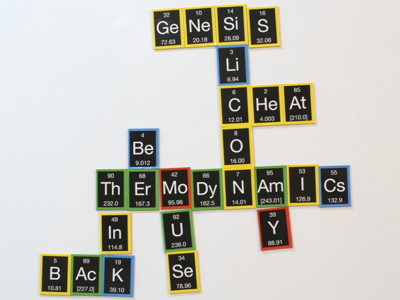Ununpentium: the essentialsExperiments resulting in the formation of element 115 were reported in February 2004 following experiments carried out between 14 July - 10 August 2003 involving scientists at Dubna (Joint Institute for Nuclear Research at the U400 cyclotron with the Dubna gas-filled recoil separator, DGFRS) in Russia in a collaboration also involving scientists at the Lawrence Livermore National Laboratory, USA. Only four nuclei were identified and the claim has not yet been ratified, but the results are now published in a reputable peer-reviewed journal.
Ununpentium: historical informationExperimental results reported in 2004 involving the bomabardment of americium-243 with calcium-48 ions are consistent with the formation in the laboratory of a few atoms of elements 113 and 115. In experiments conducted at the JINR U400 cyclotron with the Dubna gas-filled separator between July 14 and Aug. 10, 2003, atomic decay patterns were observed said to confirm the existence of element 115 and element 113. In these decay chains, element 113 is produced via the α-decay of element 115. The results are published in the 1 February 2004 issue of Physical Review C: "Experiments on the synthesis of element 115 in the reaction 243Am(48Ca,xn)291–x115", Yu. Ts. Oganessian, V. K. Utyonkoy, Yu. V. Lobanov, F. Sh. Abdullin, A. N. Polyakov, I. V. Shirokovsky, Yu. S. Tsyganov, G. G. Gulbekian, S. L. Bogomolov, A. N. Mezentsev, S. Iliev, V. G. Subbotin, A. M. Sukhov, A. A. Voinov, G. V. Buklanov, K. Subotic, V. I. Zagrebaev, M. G. Itkis, J. B. Patin, K. J. Moody, J. F. Wild, M. A. Stoyer, N. J. Stoyer, D. A. Shaughnessy, J. M. Kenneally, and R. W. Lougheed, Phys. Rev. C, 2004, 69, 021601(R). Ununpentium: physical properties
Ununpentium: orbital properties
IsolationIsolation: currently, the identification of element 115 is yet to be confirmed by IUPAC, but the experiments leading to element 115 are now published in a prestigious peer reviewed journal. As only about four atoms of element 115 have ever been made (through nuclear reactions involving fusing calcium nuclei with americium nuclei) isolation of an observable quantity has never been achieved, and may well never be. 24395Am + 4820Ca → 287115Uup + 4 1n 24395Am + 4820Ca → 288115Uup + 3 1n In these first experiments, three nuclei of the 288Uup isotope were made and one of the 287Uup isotope. All the nuclei formed decayed in less than a second by emitting α-particles. These decays resulted in isotopes of element 113 (mass number 283 or 284, containing 113 protons and either 170 or 171 neutrons). These isotopes of element 113 are also radioactive and underwent further α-decay processes to isotopes of element 111 and so on down to at least element 105 (dubnium). 287115Uup → 283113Uut + 42He (46.6 milliseconds) 288115Uup → 284113Uut + 42He (80.3 milliseconds) 288115Uup → 284113Uut + 42He (18.6 milliseconds) 288115Uup → 284113Uut + 42He (280 milliseconds) WebElements ShopWebElements now has a WebElements shop at which you can buy periodic table posters, mugs, T-shirts, games, fridge magnets, molecular models, and more. |
|||||||||
|
|



 Melting point
Melting point Boiling point
Boiling point Density of solid
Density of solid Pauling electronegativity
Pauling electronegativity First ionisation energy
First ionisation energy Second ionisation energy
Second ionisation energy


